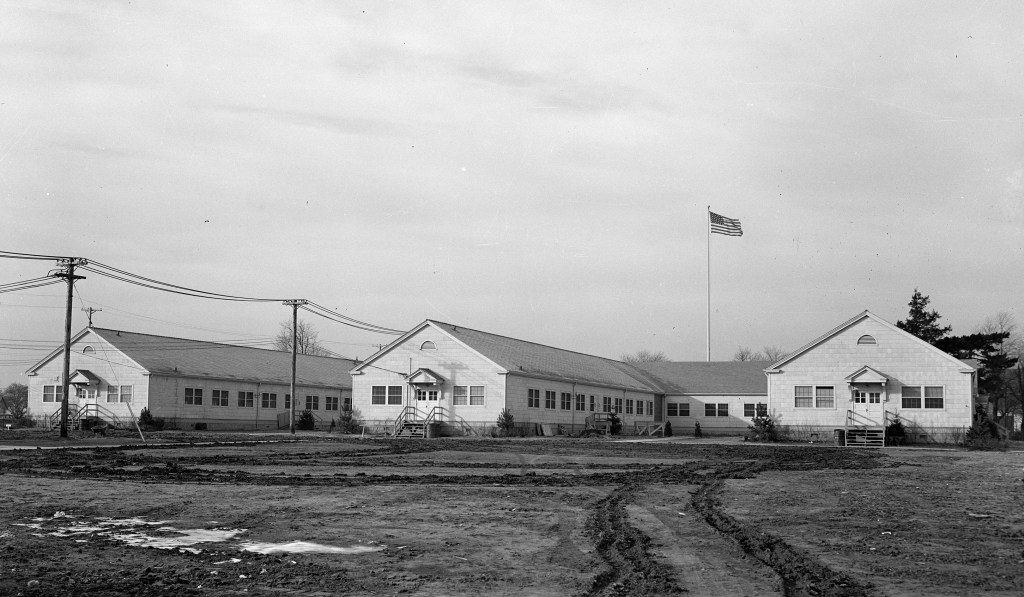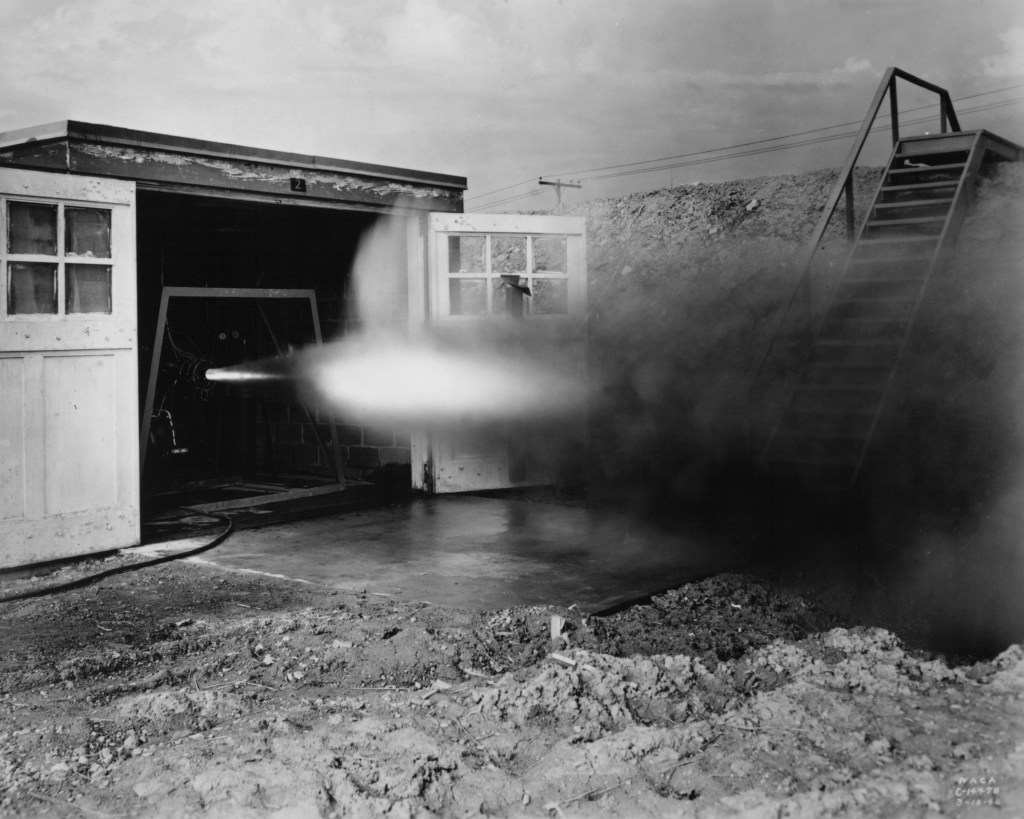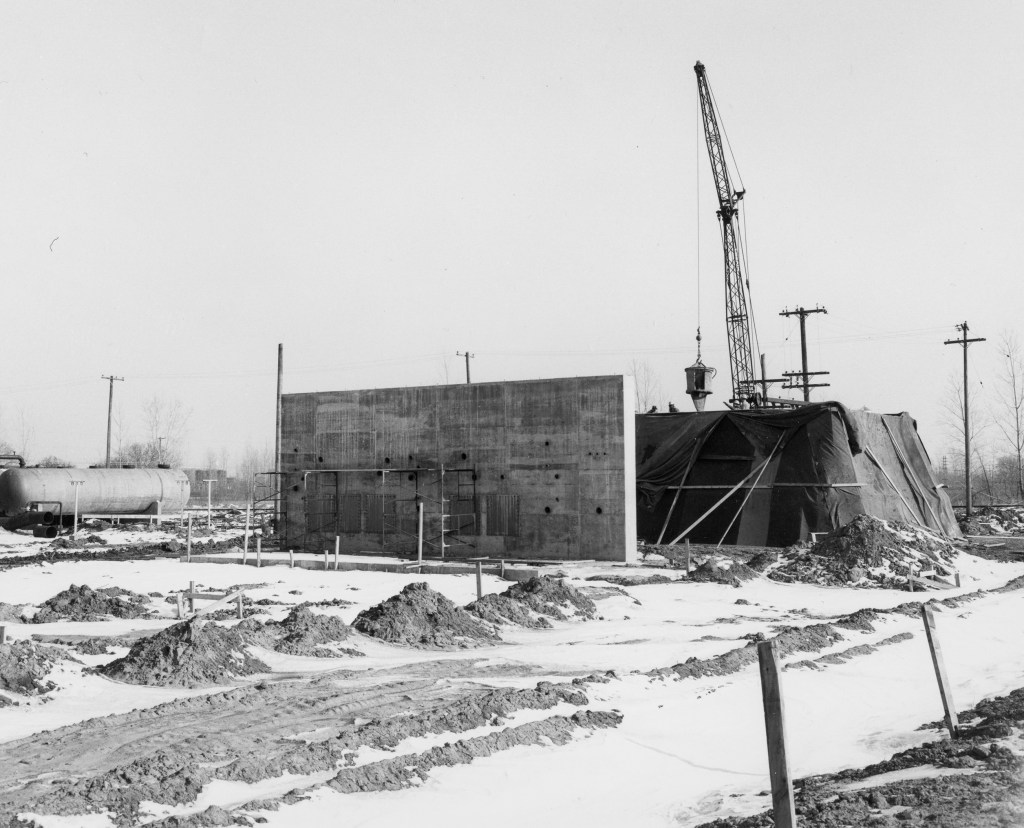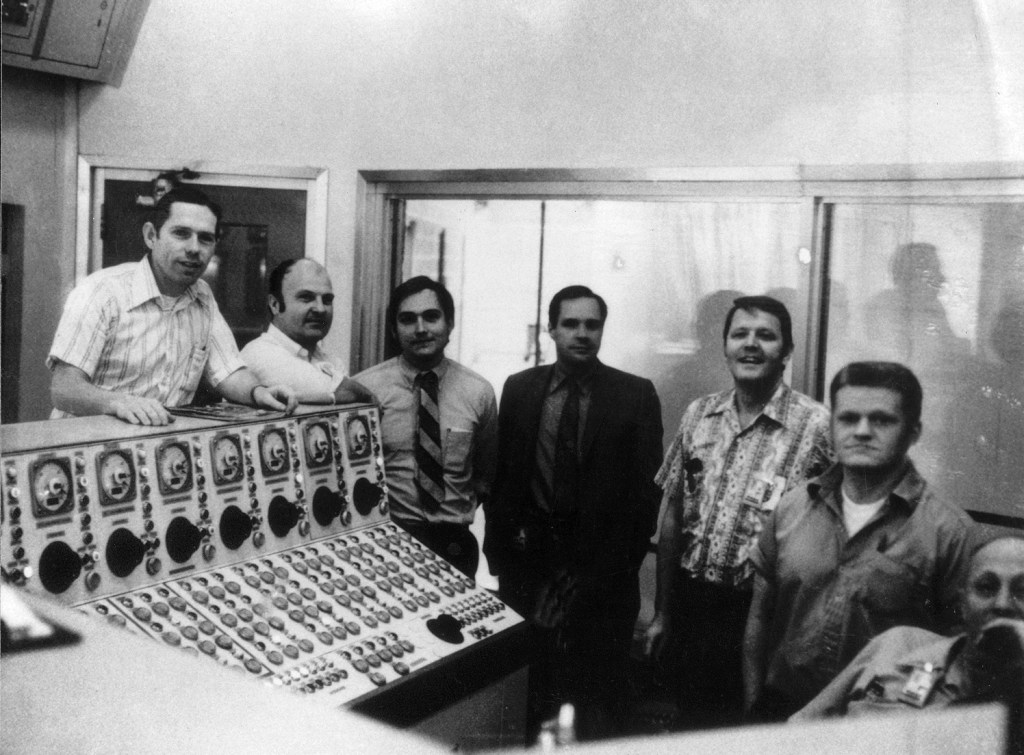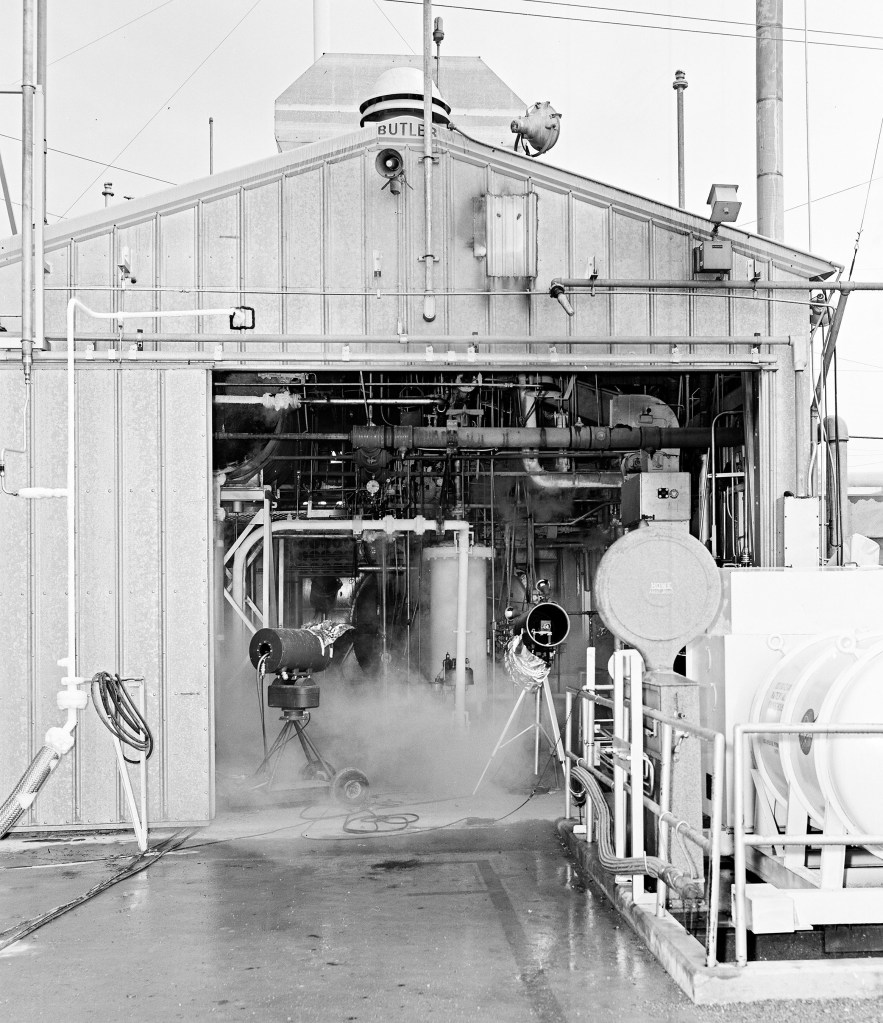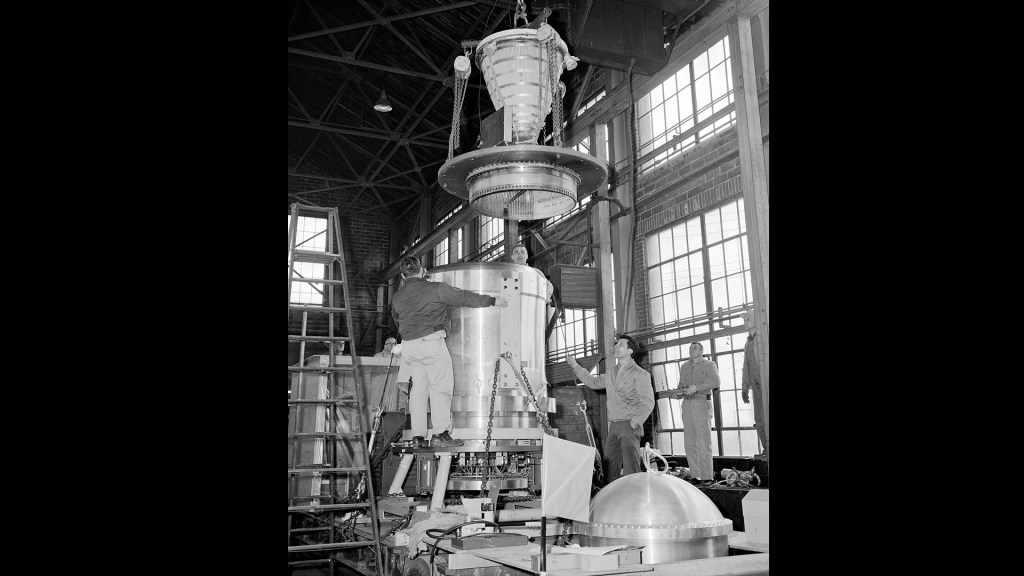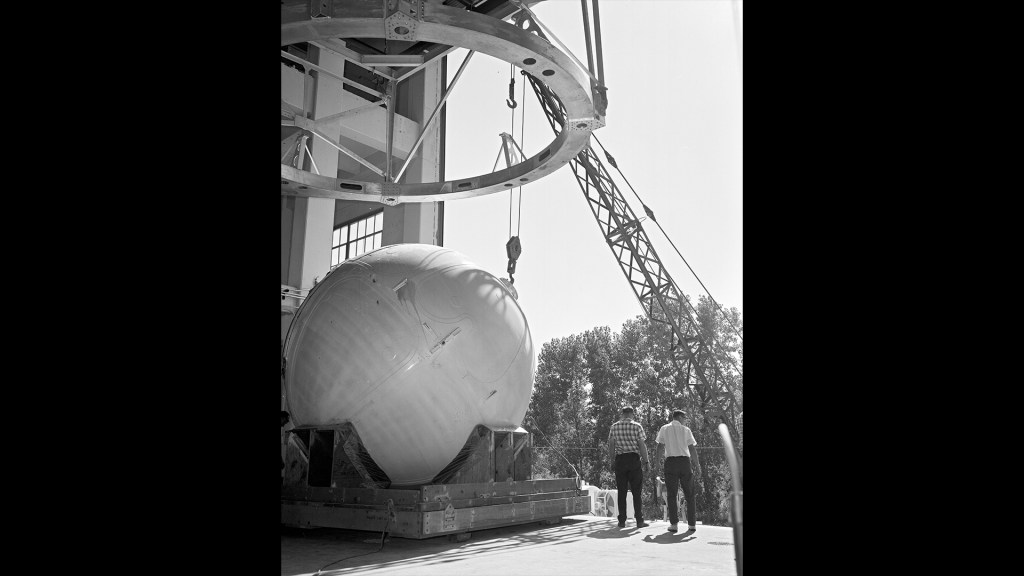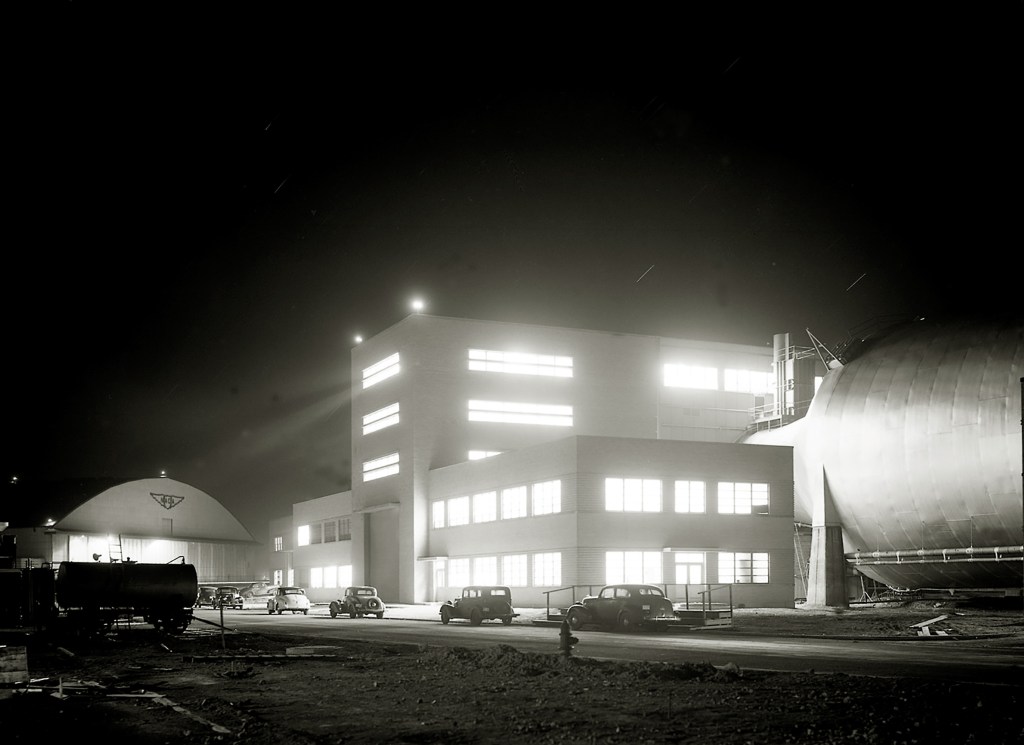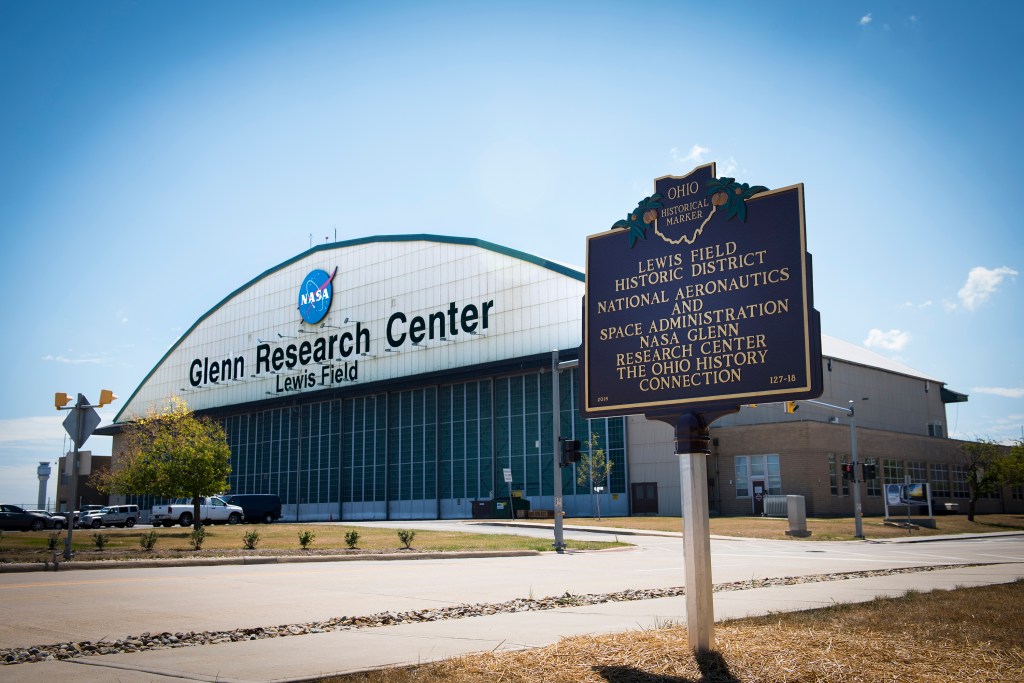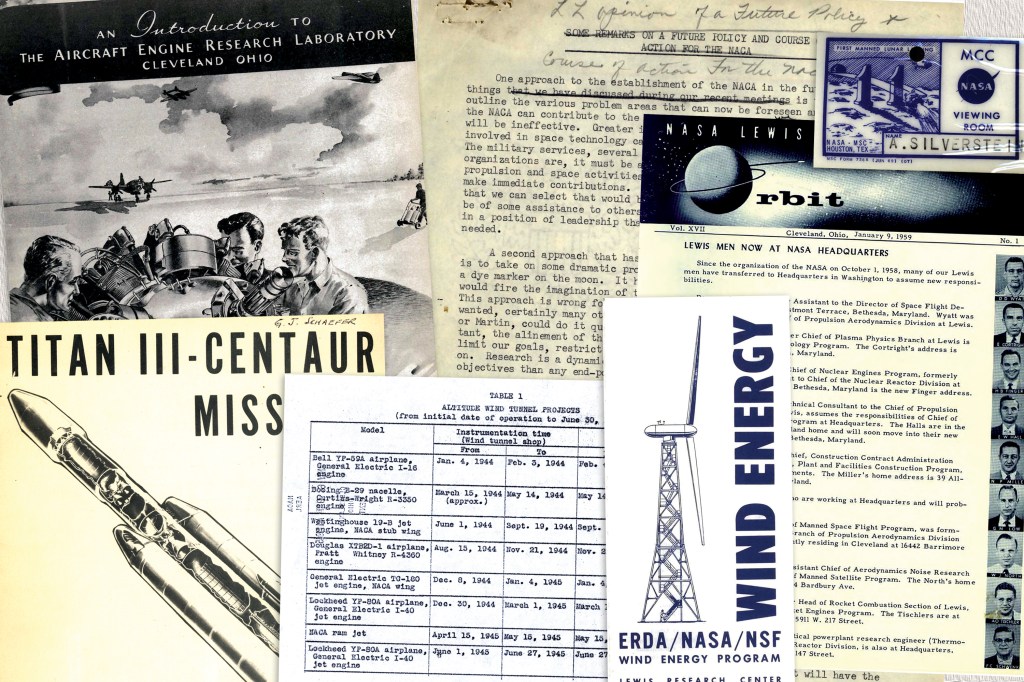NASA Glenn Research Center
Historic Facilities
Rocket Systems Area
Events Timeline
1941
- War Department seizes property to build the PBOW.1
- The NACA begins construction of the AERL [future NASA Lewis].
1943
- The NACA’s AERL officially begins operations in Cleveland.
1945
- World War II ends.
- PBOW closes after producing record amounts of ammunition for the war.
- Major NACA reorganization is done to focus on turbojets and high-speed flight.
- NACA begins modest nuclear propulsion research.
- Military sponsors initial hydrogen engine studies at OSU3 and JPL.4
1946
- Matthew-Lavio and Sons manages idle Plum Brook property.
- Air Force approves development of surface-to-surface intercontinental missile.
- Research begins on nuclear propulsion for aircraft.
1947
- Rocket Lab begins operation at the NACA lab in Cleveland, Ohio.
- First supersonic flight by Chuck Yeager in X–1.
- Cleveland Lab renamed the Lewis Flight Propulsion Laboratory.
1948
- Lewis hosts conference that discusses high-energy fuels.
- Lewis researchers begin calculating fluorine’s performance.
1949
- Plum Brook property transferred to General Services Administration
- Lewis research divisions reorganized under Abe Silverstein
1951
- NACA establishes a Special Subcommittee on Rocket Engines.
1952
- New Cryogenics Engineering Lab begins producing liquid hydrogen.
- United States tests first hydrogen bomb.
1954
- Ravenna Arsenal begins management of Plum Brook.
- Lewis improves Cell 22 at the Rocket Lab.
- First liquid-hydrogen/liquid-oxygen engine firing occurs at Rocket Lab.
- Lewis tests gaseous hydrogen in turbojet combustor.
1955
- Congress approves funding for NACA test reactor at Plum Brook.
- Air Force and Atomic Energy Commission (AEC) begin Project Rover.
- Rocketdyne and Aerojet begin design of hydrogen turbopumps.
- Lewis tests 10,000-lb-thrust fluorine engines.
1956
- Groundbreaking ceremony for Plum Brook Reactor in September.
- Lewis performs initial decontamination at Plum Brook.
1957
- Project Bee aircraft performs liquid-hydrogen-powered flights.
- Lewis creates Fluid Systems Components and Nuclear Reactor Divisions.
- Congress approves funding for Rocket Systems Area.
- General Dynamics begins design of the Centaur second-stage rocket.
- Lewis hosts NACA Inspection and Flight Propulsion Conference.
- Soviet Union launches Sputnik and Sputnik II.
- Navy’s launch of Vanguard fails.
- Regeneratively cooled hydrogen-fluorine engine run at Rocket Lab.
1958
- Lewis leases additional land at Plum Brook for Rocket Systems Area.
- Construction of Rocket Systems Area (RSA) begins.
- Silverstein transferred to Headquarters.
- Lewis inventories PBOW structures and equipment.
- AEC approves Rocketdyne axial-flow turbopump.
- NASA is officially founded on October 1.
- Pratt & Whitney begins developing RL–10 engine.
- Pilot Plant (G Site) begins operation at Plum Brook.
1959
- AEC conducts first low-power test of Kiwi-A reactor.
- Silverstein-led committee recommends high-energy fuels for upper-stage rockets.
- NASA requests additional 3500 acres at Plum Brook from the Army for additional sites.
- NASA replaces Air Force in the Rover program.
1960
- High Energy Engine Research Facility (B–1) construction underway.
- AEC conducts first full-scale Kiwi-A reactor test.
- Space Nuclear Propulsion Office (SNPO) created on August 31.
1961
- Yuri Gagarin becomes first human in space.
- President Kennedy calls for manned lunar landing.
- AEC and NASA accept Aerojet-Westinghouse NERVA5 proposal.
- Pratt & Whitney struggles with RL–10 engine problems.
- Rocket Systems Area becomes operational in the fall.
- Rocket Systems Division established at Plum Brook.
- Silverstein named director of Lewis Research Center.
1962
- E Stand, I Site, and J Site become operational.
- Alan “Hap” Johnson named Plum Brook Director.
- Congress approves $40 million for B-36, SPF7, and B-28 expansion.
- NASA substitutes Centaur for Agena rocket for Surveyor Program.
- First attempt to launch an Atlas-Centaur rocket fails on May 8.
- NASA transfers Centaur Program from Marshall to Lewis.
- Lockheed Martin designs Titan III booster.
- AEC test of Kiwi-B4-A reactor at Nevada Test Site fails.
1963
- All PBOW property officially transferred to NASA.
- Site renamed Plum Brook Station [renamed, Neil Armstrong Test Facility in 2021].
- NASA razes many PBOW structures.
- 200,000-gal hydrogen Dewar built at Plum Brook.
- Researchers conduct tests at the B–1 facility; checkout tests run throughout the fall.
- B–3 facility construction begins.
- Second Atlas-Centaur launch attempt successful.
- E Stand9 modified to accommodate Atlas-Centaur.
1964
- Engineering Building, B–2, and B–3 under construction.
- AEC tests Kiwi-B4 reactor design at Nevada Test Site.
- B–1 begins testing Kiwi reactor flow system.
- AEC successfully runs NERVA NRX–A2 engine at Nevada Test Site.
1965
- NASA budget peaks.
- Attempts to get Rocket Turbine and Controls Site (D Site) working cease.
- The Cryogenic Propellant Tank Facility (K Site) begins operation.
1966
- B–3 begins operation.
- Atlas-Centaur sends first Surveyor spacecraft to lunar surface.
- Engineering Building opens at Plum Brook.
- Lewis staff levels reach peak.
- Lewis converts Hydrogen Heat Transfer Facility (HTTF) into the HTF10.
1967
- Lewis begins reacquiring property around Plum Brook perimeter.
1968
- Apollo 8 circles Moon.
1969
- Final test conducted at B–1.
- Abe Silverstein retires and is replaced by Bruce Lundin.
- AEC tests NERVA XE engine at Nevada Test Site.
- Apollo 11 makes first lunar landing.
1970
- B–2 and SPF begin operation.
- Apollo 13 astronauts return to Earth following aborted mission.
1971
- NERVA is redesigned as smaller rocket engine.
1972
- President Nixon approves Space Shuttle Program.
- NASA fiscal year 1973 budget submitted in September without NERVA.
- Apollo 17 mission in December is final Apollo flight.
1973
- NASA cancels nuclear rocket and power programs.
- Lundin announces that Plum Brook will shut down.
- Symposium fails to generate external interest in Plum Brook Station.
- B–3 commences preparations for Centaur Standard Shroud (CSS) testing.
- Staff begin mothballing the reactor and most of the RSA.
1974
- F Site,11 B–3, HTF, B–2, and K Site conduct final runs and are mothballed.
- Titan-Centaur’s initial test flight fails.
1975
- Plum Brook Mod-0A wind turbine begins operation.
1976
- NASA review of Plum Brook outlines future options.
- Titan-Centaur sends Viking vehicles to Mars.
1977
- NASA cannibalizes some mothballed facilities.
- Titan-Centaur launches two Voyager spacecraft.
1982
- Lewis reduces B–1 and B–3 readiness status to Category 3.
1985
- Operation of Plum Brook wind turbine ceases.
- Office of Management and Budget recommends excessing Plum Brook.
1986
- Office of Management and Budget decides to restore Plum Brook.
1987
- Plum Brook begins reactivating its large test facilities.
1989
- First test run conducted in reactivated SPF chamber.
- K Site becomes operational with new slush hydrogen generator.
1993
- HTF begins operations.
1996
- B–2 facility fully restored.
1998
- Demolition of Plum Brook Reactor Facility commences
2004
- NASA offers centers funding to remove unused facilities.
- E Stand is demolished.
2007
- Lewis makes plans to remove Rocket Systems Area.
2009
2010
- B–1 and B–3 stands and Gas Handling Area are demolished.
2012
- H Control Building, K Site’s control building, and J–515 hortonsphere are demolished.
- Plum Brook Reactor decommissioning is completed.
Testing Timeline
1958
- Small gas generators (G Site)
1959
- Small gas generators (G Site)
1960
1961
- Liquid-hydrogen centrifugal pump (A Site’s Hydrogen Loop)
- 15,000-rpm hydrogen axial-flow pumps (G Site’s Liquid Hydrogen Pump)
- Three-stage NERVA turbine and six-stage Hy-Nut turbine (G Site’s Turbine Facility)
- Gaseous-hydrogen/liquid-oxygen engine (J–1)
- Gaseous-hydrogen/liquid-fluorine engine (J–2)
1962
- Liquid-hydrogen centrifugal pump (A Site Hydrogen Loop)
- Liquid-hydrogen pump (C Site2 Boiling Fluids Rig)
- Vibrational analysis on SERT I,3 Ranger accelerometer, and Sky Bolt instrumentation (E Stand4)
- Vibrational analysis on Mercury Evaporating Condensation Analysis (MECA) program (E Stand4)
- Lewis liquid-fluorine centrifugal turbopumps (Fluorine Pump Research Facility, I Site)
- Gaseous-hydrogen/liquid-oxygen engine (J–1)
- Copper hydrogen-oxygen engine for nuclear rocket heat transfer (J–1)
- Liquid-oxygen/liquid-hydrogen pressure-fed engine (J–2)
- Tank boiloffs (J–416)
1963
- Impeller designs for liquid-hydrogen centrifugal pump (A Site’s Hydrogen Loop)
- Inducer performance in heat from nuclear rocket (C Site’s Boiling Fluids Rig)
- Impeller matching with centrifugal hydrogen pump (C Site’s Pump Rig)
- Vibrational analysis for MECA17 program (E Stand)
- Atlas load tests (E Stand)
- Hydrogen-water heat exchanger for nuclear rocket (F Site)
- External insulation system for Centaur tank (F Site)
- Pump with hydrogen-cooled bearings (G Site’s Turbine Building)
- Lewis liquid-fluorine centrifugal turbopumps (I Site)
- P&W RL–10 fluorine turbopumps (I Site)
- Hydrogen burnoffs for Hydrogen Heat Transfer (HHTF) design (J–1)
- Copper hydrogen-oxygen engine for nuclear rocket heat transfer (J–1)
- Throttling of a liquid-oxygen/liquid-hydrogen engine ( J–318)
- Linde superinsulation and Centaur constrictively wrapped tank (J–3 and J–4)
- Fluorine/fluorine oxygen (FLOX) materials compatibility (J–5)
1964
- Impeller designs for liquid-hydrogen centrifugal pump (A Site’s Hydrogen Loop)
- Oxygen turbopump for the M–1 engine (A’s Site Oxygen Loop)
- NERVA engine bootstrapping and chilldown (B–1)
- Inducer performance in heat from nuclear rocket (C Site’s Boiling Fluids Rig)
- Slush hydrogen pumping (C Site’s Boiling Fluids Rig)
- Impeller matching with centrifugal hydrogen pump (C Site’s Pump Rig)
- Atlas/Centaur longitudinal and latitudinal dynamics (E Stand)
- Hydrogen-water heat exchanger for nuclear rocket (F Site)
- External insulation system for Centaur tank (F Site)
- Pump with hydrogen-cooled bearings (G Site’s Turbine Building)
- Small-scale axial-flow hydrogen pump (G Site’s Pump Building)
- Lewis liquid-fluorine centrifugal turbopumps and P&W RL–10 fluorine turbopumps (I Site)
- Injectors for hydrogen-oxygen engines; regeneratively cooled hydrogen engines (J–1)
- Linde superinsulation (J–3)
- Arthur D. Little gold Mylar insulation (J–3 and J–4)
- Fluorine/FLOX materials compatibility and fluorine spills (J–5)
1965
- Inducer blade loadings on a liquid-hydrogen centrifugal pump (A Site’s Hydrogen Loop)
- Impeller matching with centrifugal hydrogen pump (C’s Site Pump Rig)
- Centaur fairing loads (E Stand)
- Hydrogen-water heat exchanger for nuclear rocket (F Site)
- P&W RL–10 fluorine turbopumps (I Site)
- Injectors for hydrogen-oxygen engines (J-1)
- Regeneratively cooled hydrogen engines (J–1)
- K Site 13-ft tank system (J–2)
1966
- Inducer blade loadings on a liquid-hydrogen centrifugal pump (A Site’s Hydrogen Loop)
- NERVA engine turbopump, bootstrap, and chilldown (B–3)
- Minimal pressure required to pump hydrogen (C Site’s Boiling Fluids Rig)
- Impeller matching with centrifugal hydrogen pump (C Site’s Pump Rig)
- Atlas/Centaur post-wrinkling strength (E Stand)
- Hydrogen-water heat exchanger for nuclear rocket (F Site)
- Pratt & Whitney FLOX/methane turbopump (I Site)
- Injectors for hydrogen-oxygen engines (J-1)
- Regeneratively cooled hydrogen engines (J–1)
- Self-Evacuating Multilayer Insulation (SEMI) (J–3)
- 5-ft tank (K Site)
1967
- Four-stage axial-flow hydrogen pump (A Site’s Hydrogen Loop)
- Advanced Centaur boiloff (B–1)
- Atlas/Centaur bulkhead and duct dynamics (E Stand)
- Injectors for hydrogen-oxygen engines (J-1)
- Regeneratively cooled hydrogen engines (J–1)
- Arthur D. Little insulation (J–3)
- 13-ft tank and 9-ft tank (K Site)
1968
- Four-stage axial-flow hydrogen pump (A Site’s Hydrogen Loop)
- Advanced Centaur boiloff and outflow (B–1)
- Comparison of different inducer blade shapes and angles (C Site’s Boiling Fluids Rig)
- Atlas/Centaur duct dynamics (E Stand)
- Centaur tank cold shock (F Site)
- Injectors for hydrogen-oxygen engines (j-1)
- Regeneratively cooled hydrogen engines (J–1)
- Arthur D. Little insulation and copper heat transfer tank (J–3)
- 7-ft tank and 5-ft tank (K Site)
1969
- Advanced Centaur outflow (B–1)
- 5-ft tank and multilayer and self-evacuating insulation (K Site)
1970
- Shadowshield (K Site)
1971
- Shadowshield and multilayer insulation (K Site)
1972
- Centaur shroud half-scale, hinges, and jettison (B–3)
- Multilayer insulation (K Site)
1973
- Centaur shroud tanking, seal, and structural integrity (B–3)
- Cryogenic Storage Test Vehicle (K Site)
1974
- Centaur shroud twang and structural integrity (B–3)
- Liquid-oxygen choked flow (F Site)
- Cryogenic Storage Test Vehicle (K Site)
Footnotes
- Plum Brook Ordnance Works (PBOW)
- Aircraft Engine Research Laboratory (AERL)
- Ohio State University (OSU)
- Jet Propulsion Laboratory (JPL)
- Nuclear Engine for Rocket Vehicle Application (NERVA)
- Nuclear Rocket Dynamics and Control Facility (B–3)
- Space Power Facility (SPF)
- Spacecraft Propulsion Research Facility (B–2)
- Dynamics Stand (E Stand)
- Hypersonic Tunnel Facility (HTF)
- Hydraulics Research Laboratory (F Site)
- Liquid Hydrogen Pump Facility (A Site)
- Turbopump Facility (C Site)
- Fluorine Pump Research Facility (I Site)
- Materials Compatibility Facility (J-5)
- Tank Test Facility (J-4)
- Mercury Evaporating and Condensing Analysis (MECA)
- Vacuum Environment Facility (J-3)





























